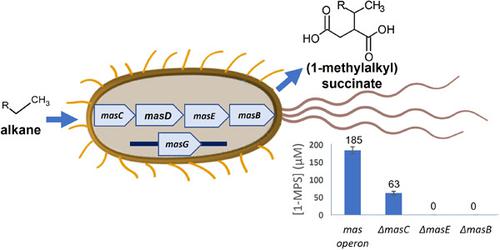当前位置:
X-MOL 学术
›
Biotechnol. Bioeng.
›
论文详情
Our official English website, www.x-mol.net, welcomes your
feedback! (Note: you will need to create a separate account there.)
Engineering Escherichia coli for anaerobic alkane activation: Biosynthesis of (1-methylalkyl)succinates
Biotechnology and Bioengineering ( IF 3.5 ) Pub Date : 2021-10-11 , DOI: 10.1002/bit.27956 Yixi Wang 1 , Nam Nguyen 1 , Seung H Lee 2, 3 , Qinxuan Wang 4 , Jeremy A May 4 , Ramon Gonzalez 2 , Patrick C Cirino 1
Biotechnology and Bioengineering ( IF 3.5 ) Pub Date : 2021-10-11 , DOI: 10.1002/bit.27956 Yixi Wang 1 , Nam Nguyen 1 , Seung H Lee 2, 3 , Qinxuan Wang 4 , Jeremy A May 4 , Ramon Gonzalez 2 , Patrick C Cirino 1
Affiliation

|
In anoxic environments, microbial activation of alkanes for subsequent metabolism occurs most commonly through the addition of fumarate to a subterminal carbon, producing an alkylsuccinate. Alkylsuccinate synthases are complex, multi-subunit enzymes that utilize a catalytic glycyl radical and require a partner, activating enzyme for hydrogen abstraction. While many genes encoding putative alkylsuccinate synthases have been identified, primarily from nitrate- and sulfate-reducing bacteria, few have been characterized and none have been reported to be functionally expressed in a heterologous host. Here, we describe the functional expression of the (1-methylalkyl)succinate synthase (Mas) system from Azoarcus sp. strain HxN1 in recombinant Escherichia coli. Mass spectrometry confirms anaerobic biosynthesis of the expected products of fumarate addition to hexane, butane, and propane. Maximum production of (1-methylpentyl)succinate is observed when masC, masD, masE, masB, and masG are all present on the expression plasmid; omitting masC reduces production by 66% while omitting any other gene eliminates production. Meanwhile, deleting iscR (encoding the repressor of the E. coli iron–sulfur cluster operon) improves product titer, as does performing the biotransformation at reduced temperature (18°C), both suggesting alkylsuccinate biosynthesis is largely limited by functional expression of this enzyme system.
中文翻译:

用于厌氧烷烃活化的工程大肠杆菌:(1-甲基烷基)琥珀酸盐的生物合成
在缺氧环境中,烷烃的微生物活化以进行后续代谢最常见的方式是通过将富马酸盐添加到亚末端碳上,产生烷基琥珀酸盐。烷基琥珀酸合酶是复杂的多亚基酶,它利用催化甘氨酰自由基并需要一个伙伴,激活酶以进行氢提取。虽然已经鉴定了许多编码假定的烷基琥珀酸合酶的基因,主要来自硝酸盐和硫酸盐还原菌,但很少有基因被表征,并且没有报道在异源宿主中功能性表达。在这里,我们描述了来自Azoarcus sp的 (1-甲基烷基) 琥珀酸合酶 (Mas) 系统的功能表达。重组大肠杆菌中的 HxN1菌株. 质谱证实了将富马酸盐加到己烷、丁烷和丙烷中的预期产物的厌氧生物合成。当masC、masD、masE、masB和masG都存在于表达质粒上时,观察到(1-甲基戊基)琥珀酸的最大产量;省略masC会减少 66% 的产量,而省略任何其他基因会消除产量。同时,删除iscR(编码大肠杆菌的阻遏物)铁硫簇操纵子)提高了产物滴度,在降低的温度(18°C)下进行生物转化也是如此,这两者都表明烷基琥珀酸的生物合成在很大程度上受到该酶系统的功能表达的限制。
更新日期:2021-12-04
中文翻译:

用于厌氧烷烃活化的工程大肠杆菌:(1-甲基烷基)琥珀酸盐的生物合成
在缺氧环境中,烷烃的微生物活化以进行后续代谢最常见的方式是通过将富马酸盐添加到亚末端碳上,产生烷基琥珀酸盐。烷基琥珀酸合酶是复杂的多亚基酶,它利用催化甘氨酰自由基并需要一个伙伴,激活酶以进行氢提取。虽然已经鉴定了许多编码假定的烷基琥珀酸合酶的基因,主要来自硝酸盐和硫酸盐还原菌,但很少有基因被表征,并且没有报道在异源宿主中功能性表达。在这里,我们描述了来自Azoarcus sp的 (1-甲基烷基) 琥珀酸合酶 (Mas) 系统的功能表达。重组大肠杆菌中的 HxN1菌株. 质谱证实了将富马酸盐加到己烷、丁烷和丙烷中的预期产物的厌氧生物合成。当masC、masD、masE、masB和masG都存在于表达质粒上时,观察到(1-甲基戊基)琥珀酸的最大产量;省略masC会减少 66% 的产量,而省略任何其他基因会消除产量。同时,删除iscR(编码大肠杆菌的阻遏物)铁硫簇操纵子)提高了产物滴度,在降低的温度(18°C)下进行生物转化也是如此,这两者都表明烷基琥珀酸的生物合成在很大程度上受到该酶系统的功能表达的限制。










































 京公网安备 11010802027423号
京公网安备 11010802027423号